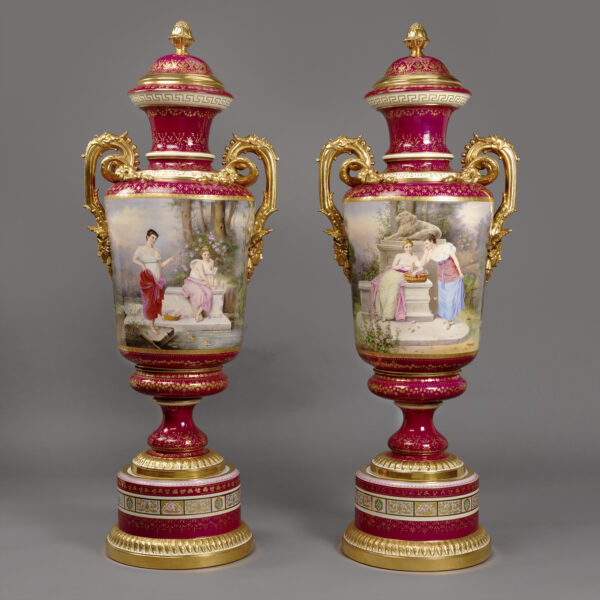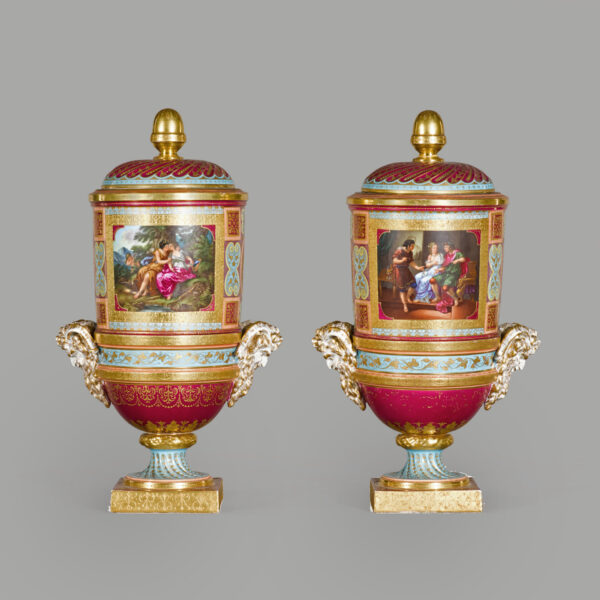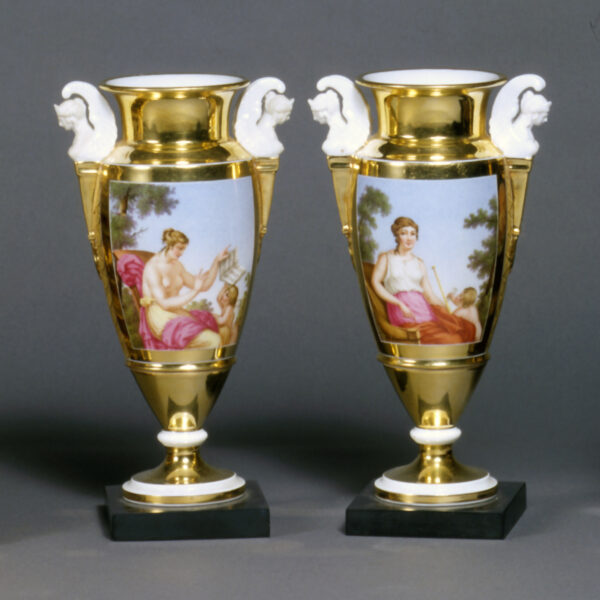Sèvres
Un par de jarrones de presentación de porcelana de Sèvres excepcionalmente raros
£29,000
A Pair of Sèvres Porcelain Presentation Vases, Designed by Albert-Ernest Carrier-Belleuse. France, Dated 1874. Marked to the base of each vase ‘Doré...
Dimensiones
Height: 54 cm (22 in)Diameter: 20 cm (8 in)
Descripción
A Pair of Sèvres Porcelain Presentation Vases, Designed by Albert-Ernest Carrier-Belleuse. France, Dated 1874.
Marked to the base of each vase ‘Doré A Sèvres, S74’, and incised ‘AD-74, 3’, and ‘P.V-R 73-11-A.
The incised initials almost certainly refer to François-Alexandre David, gilder and painter at the Sèvres manufactory between 1844 and 1882.
Each vase is of an unusual pale lavender colour, the distinctive ‘bottle’ shape with elongated faceted necks derived from early Persian metalware. They are described in the Sèvres records from 1874 as ‘Vase Bouteille Persanne’. The main body is centred by a scrolling strapwork cartouche containing the inscription:
EXPOSITION DES BEAUX-ARTS, ROUSSEAU (PH), MEMBRE DU JURY, SECTION DE PEINTURE, 1874.
This very likely means that these vases were commissioned as an award for the painter Philippe Rousseau to commemorate his election to the committee which judged the paintings exhibited at the 1874 Paris Salon.
Philippe Rousseau (1816 – 1887) was an awarded French academic painter. His work is in The National Gallery London and other museum collections. The Salon, the official art exhibition of the Académie des Beaux Arts in Paris, was generally thought of as the most important annual exhibition in the world. As well as being a showcase for established artists, the exhibition gave up-and-coming artists the chance to present their work to discerning viewers.
In April 1874, a group of artists, the ones rejected by the Salon jury, opened an exhibition independent of the Salon as the Société Anonyme des Artistes, Peintres, Sculpteurs, Graveurs. This was to be the first true exhibition of Impressionist art; the contributing artists included Cézanne, Pissarro, Renoir, Degas, Monet, Manet, and his sister-in-law Berthe Morisot.
France, Dated 1874.
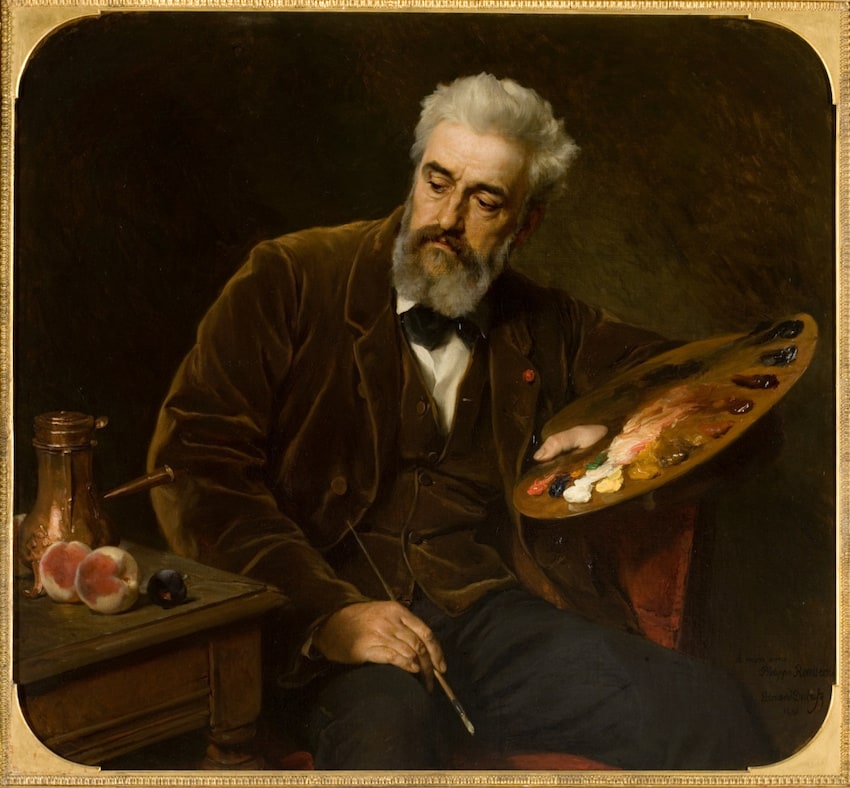
Philippe Rousseau (1816-1888) painted by Edouard Dubufe in 1876
(© Musée d’Orsay, Dist. RMN-Grand Palais).
Carrier-Belleuse
Albert Ernest Carrier-Belleuse (1824-1887), fue un importante escultor parisino que firmaba sus obras como "Carrier".
El escultor Fauconnier formó a Carrier-Belleuse antes de ingresar en la Escuela de Bellas Artes de París en 1840, donde estudió con David d'Angers. Más tarde abandonó esta formación formal para desarrollar su interés por un estilo más decorativo y romántico, en el que demostró una sana independencia. Carrier-Belleuse debutó en el Salón en 1851 antes de trasladarse a Inglaterra, donde trabajó en el taller de diseño de la fábrica de porcelana de Minton en Staffordshire hasta 1854. Aquí se formó con Léon Arnoux.
A su regreso a París, en 1855, emprendió una serie de obras importantes que incluyeron trabajos en el Louvre, el Hôtel de Païva, la Ópera, el Hôtel de Ville y el Théâtre Français. Como uno de los escultores más prolíficos y versátiles del siglo XIX, se dio a conocer con el grupo "Salve Regina", expuesto en el Salón de París de 1861. Sus obras posteriores "Bacante" (1863) y "El Mesías" (1867) le valieron medallas y la Legión de Honor, el máximo reconocimiento.
In the last years of the Second Empire he executed many public commissions and was highly regarded by Napoléon III, who referred to him as ‘our Clodion’.
Carrier-Belleuse worked in every medium, both traditional and modern, even experimenting with galvanoplasty and electroplating. His combination of materials, such as porcelain for the features of his bronze statuettes, anticipated the chryselephantine figures of the turn of the century. In 1875 he was appointed Director of Works at the Sèvres porcelain factory. He employed a galaxy of rising young sculptors as assistants, who at one time or another included Rodin and Mathurin Moreau, though his own work showed little sympathy with the modern movement which Rodin was instrumental in developing. His bronzes include many busts of historic and contemporary celebrities, classical and allegorical figures, figures in period costume, nude statuettes, bas-reliefs and even sculptural staircases and interior decoration.
Bibliografía:
Meyer, Jonathan. Great Exhibitions - London, New York, Paris, Philadelphia, 1851-1900, Antique Collectors' Club, (Woodbridge, UK), 2006; p 194.
Mestdagh, Camille y Lécoules, Pierre. L'Ameublement d'Art Français, 1850-1900, Les Editions de L'Amateur, (París), 2010; pps. 61, 150.
Segard, Achille. A. Carrier-Belleuse, H. Champion, (París), 1928.
Fecha
Dated 1874
Origen
Francés
Medio
Porcelana
The Sèvres Porcelain manufactory was founded to the east of Paris in the disused royal château of Vincennes, late in 1739-40.
It was not until 1756 that it moved to the village of Sèvres, west of Paris, strategically placed en route to King Louis XV’s palace of Versailles. Here it was also adjacent to Louis’s mistress Madame de Pompadour’s own château at Bellevue.
A great lover of Sèvres porcelain, she was delighted with the factory’s new location – as she knew she could entice Louis to take a greater interest in it when it was so near to their own residences. Indeed, the King became such a keen patron of the factory that when in 1759 it ran into financial difficulties, he bought out the shareholders and became the sole proprietor. The factory remained a royal enterprise until the French Revolution, when it was nationalised.
Sèvres’ position at the beginning of the nineteenth century was extremely precarious. No longer a royal enterprise, and having lost much of its clientele during the revolution, its funding reflected the ruinous state of the French economy.
However the Manufactory rose to this challenge, achieving the remarkable accomplishment of staying continuously in the forefront of European ceramic production despite the myriad changes in technology, taste, and patronage that occurred during this tumultuous century. The vast and diverse production of the Sèvres factory in the nineteenth century resists easy characterisation, and its history during this period reflects many of the changes affecting French society in the years between 1800 and 1900.
Important designers and influential artistic directors were always at the forefront of Sèvres’s innovation. Famous artists who designed for Sèvres have included Louis-Simon Boizot, Théophile Fragonard, Hector Guimard, Serge Poliakoff , Auguste Rodin and Louise Bourgeois. One of the most influential artists was Albert Ernest Carrier-Belleuse who became artistic director in 1876 and was famed for his designs.
Bibliography:
Meyer, Jonathan. Great Exhibitions – London, New York, Paris, Philadelphia, 1851-1900, Antique Collectors’ Club, (Woodbridge, UK), 2006.
Savill, Rosalind. The Wallace Collection: Catalogue of Sèvres Porcelain, Vol III, Paul Holberton, 1998.
Paredes, Liana. Sèvres Then and Now: Tradition and Innovation in Porcelain’, 1750-2000, D Giles Ltd, 2009.
Meyer, Jonathan. Great Exhibitions – London, New York, Paris, Philadelphia, 1851-1900, Antique Collectors’ Club, (Woodbridge, UK), 2006; p 194.
Mestdagh, Camille y Lécoules, Pierre. L'Ameublement d'Art Français, 1850-1900, Les Editions de L'Amateur, (París), 2010; pps. 61, 150.
Segard, Achille. A. Carrier-Belleuse, H. Champion, (París), 1928.
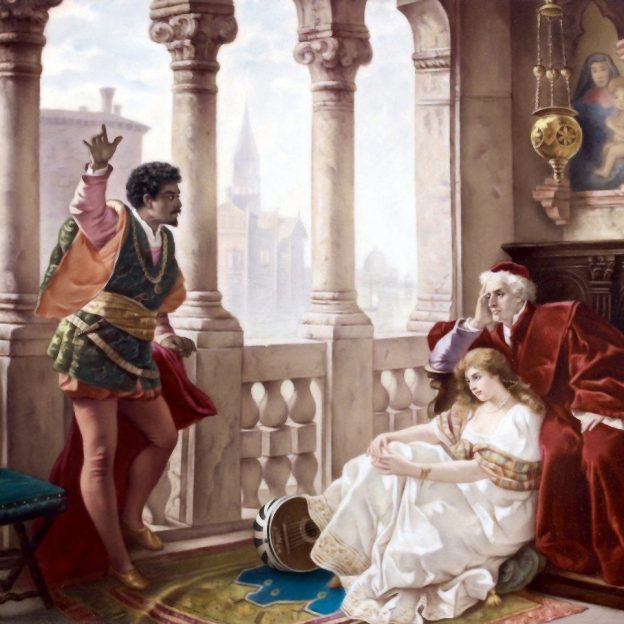




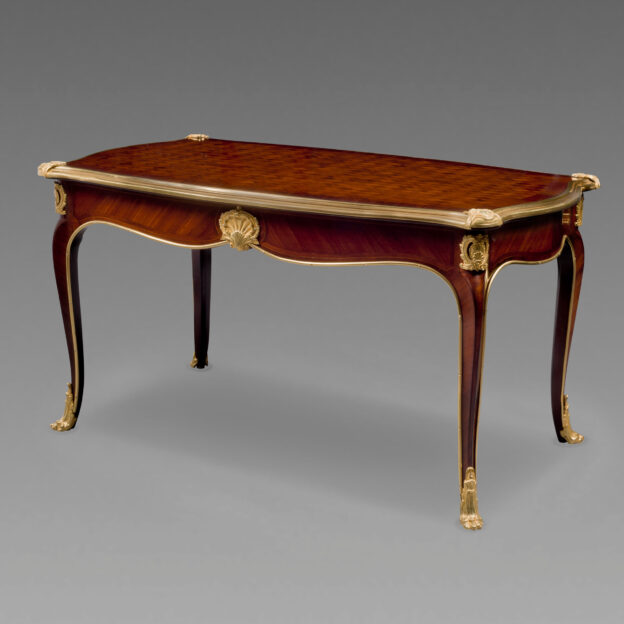
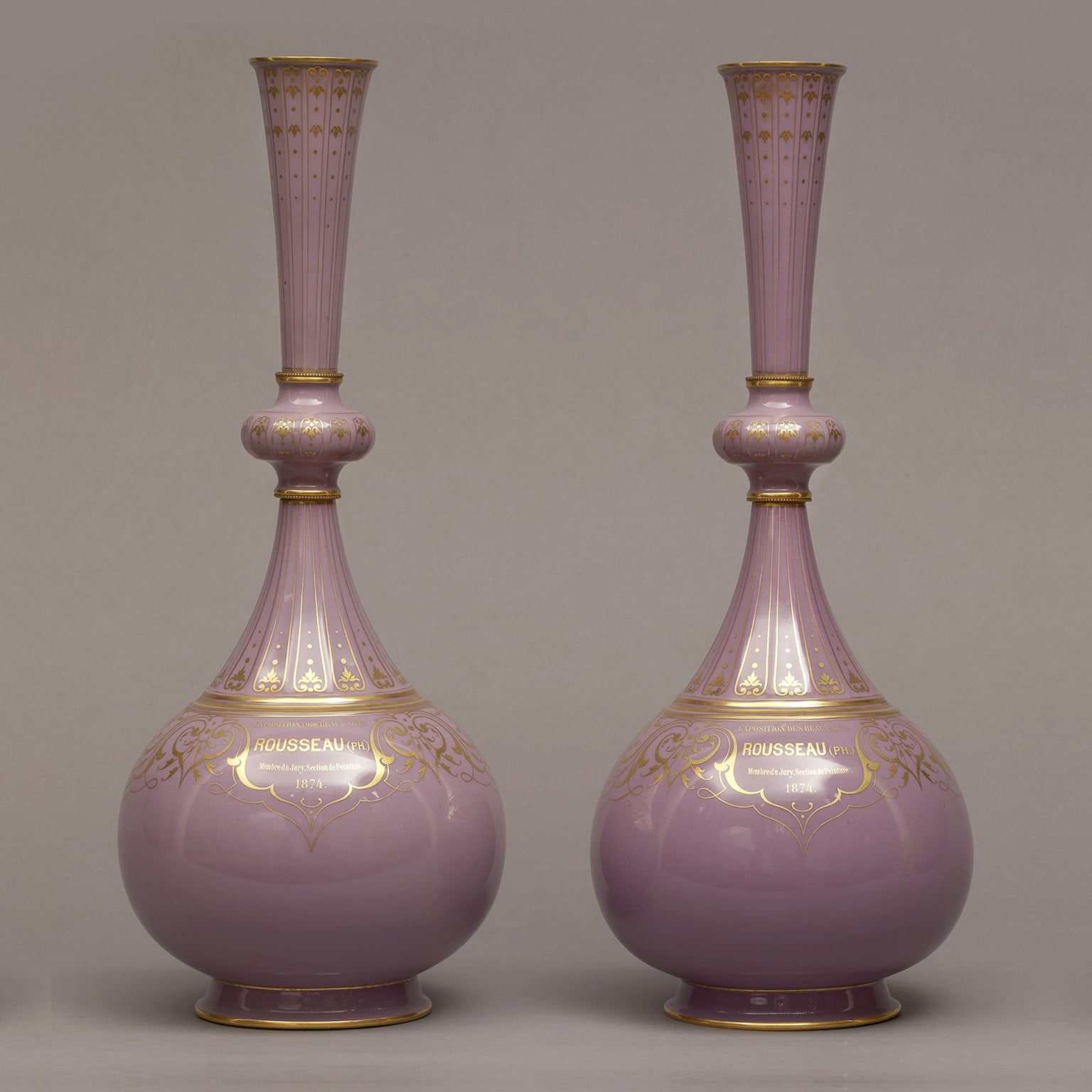


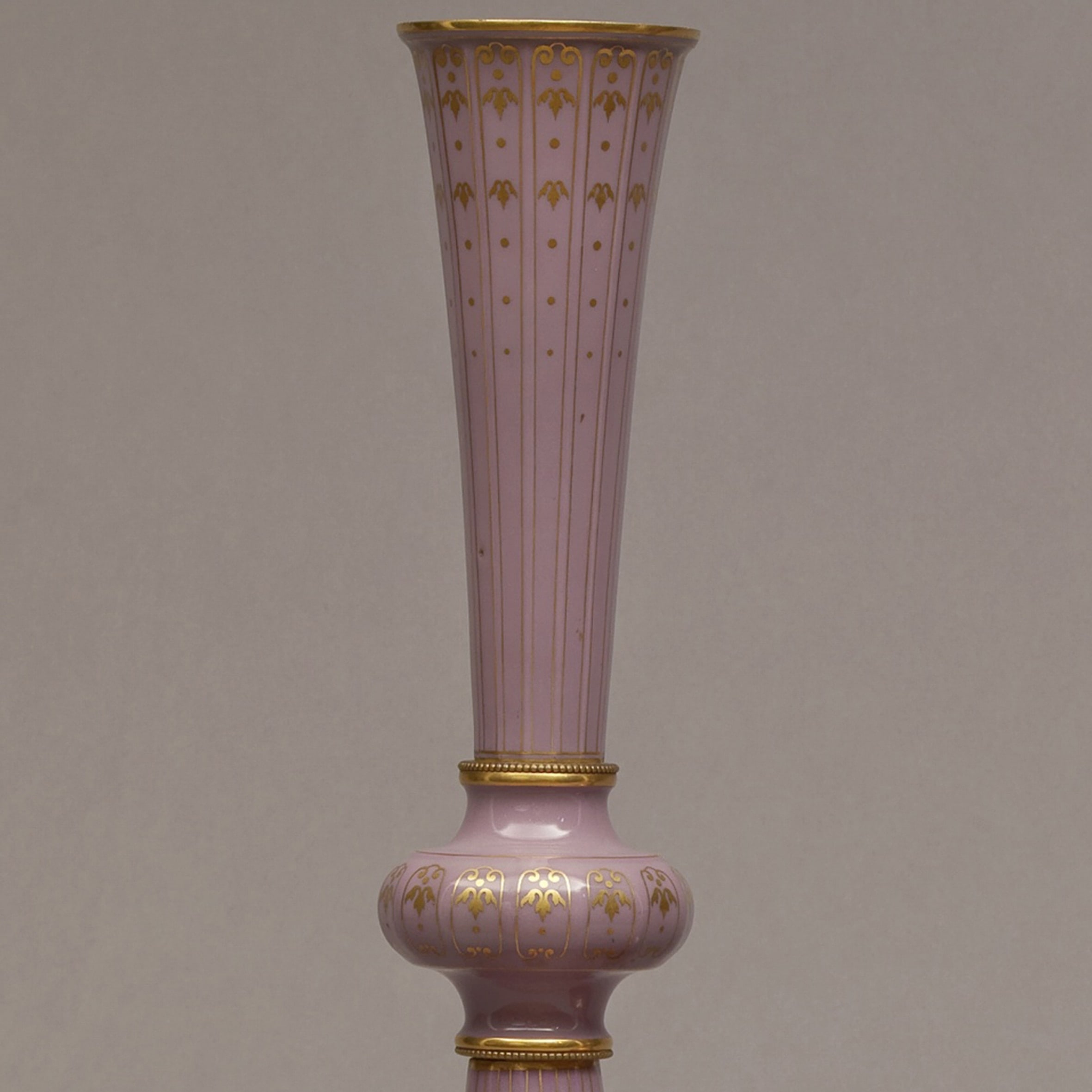

 Imprimir
Imprimir